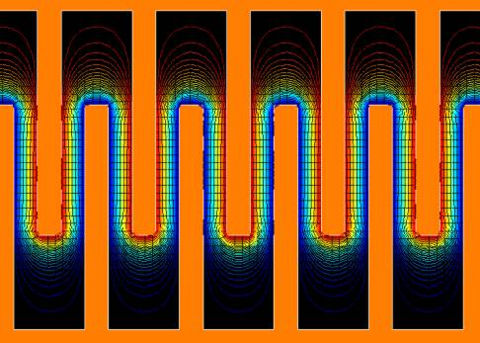
|
2D Electrostatic Field Modeling:
2D “Christmas tree” electrostatic field. The contours in the image below represents equipotentials
of electric field between “Christmas tree” shaped shells
of arbitrary material set to constant potential values. This type
of problem can be solved extremely rapidly using standard commercial
electrostatic field programs. Typically one imports the problem
geometry in any of various drawing formats, and then assigns material
and boundary properties. This particular problem was solved using
a commercial program based on the boundary element method (BEM).
BEM is an efficient computational approach for such a problem because
it does not require gridding of uniform material regions. This example
merely illustrates the ease of solution of electrostatic fields
in arbitrary 2D or 3D axisymmetric materials. 2D electrostatic modeling of a comb-drive capacitive actuator. The image below illustrates equipotentials of
the electric field in the air gap between the fingers of a comb-drive.
Comb drives can be etched using standard MEMS fabrication techniques,
and are commonly used as micro-electro-mechanical actuators. The
closing force produced by a specific finger geometry, voltage, gap
material, and position may be analytically estimated or simulated.
This example was also solved using a boundary element method (BEM)
program. |
 |


